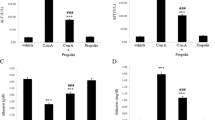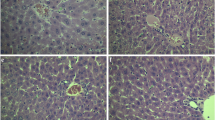Abstract
The effect of ginsenoside Rg1 (Rg1) on hepatic damage caused by concanavalin A (Con A) has not been fully elucidated. This study was designed to evaluate the protective effect of Rg1 on Con A-induced hepatitis in mice and explore the potential mechanisms of this effect. C57BL/6 mice were divided randomly into the following four experimental groups: phosphate-buffered saline group, Rg1 group, Con A group, Con A + Rg1 group. Mice received Rg1 (20 mg/kg) 3 h before intravenous administration of Con A (15 mg/kg). Levels of alanine transaminase, aspartate transaminase and cytokine production were measured, the amount of phosphorylated IκBα and p65 were tested, the numbers of CD4+ and CD8+ T lymphocytes infiltrated in the blood, spleen and liver were calculated, intercellular adhesion molecule-1 (ICAM-1) and interferon-inducible chemokine-10 (CXCL-10) levels were measured and histological examination of the livers was conducted. Pretreatment with Rg1 markedly reduced the elevated levels of serum aminotransferase, ameliorated liver damage and suppressed proinflammatory cytokines secretion via inhibition NF-κB activity following Con A injection of mice. Furthermore, Rg1 administration reduced ICAM-1 and CXCL-10 mRNA expression in the liver as well as the number of CD4+ and CD8+ T lymphocytes infiltrating in the liver. Rg1 reduced the incidence of liver damage through inhibition of the proinflammatory response and suppressed the recruitment of CD4+ and CD8+ T lymphocytes to the liver. These data indicate that Rg1 represents a novel agent for the treatment of T lymphocyte-dependent liver injury.





Similar content being viewed by others
Abbreviations
- Con A:
-
Concanavalin A
- ALT:
-
Alanine aminotransferase
- AST:
-
Aspartate aminotransferase
- ICAM-1:
-
Intercellular adhesion molecular-1
- CXCL-10:
-
Interferon inducible
References
Watanabe S, Ohnuki K, Hara Y, Ishida Y, Ikarashi Y, Ogawa S, Kishimoto H, Tanabe K, Abe R (2010) Suppression of Con A-induced hepatitis induction in ICOS-deficient mice. Immunol Lett 128(1):51–58
Tiegs G, Hentschel J, Wendel A (1992) A T cell-dependent experimental liver injury in mice inducible by concanavalin A. J Clin Invest 90(1):196–203
Liu LL, Gong LK, Wang H, Xiao Y, Wu XF, Zhang YH, Xue X, Qi XM, Ren J (2007) Baicalin protects mouse from concanavalin A-induced liver injury through inhibition of cytokine production and hepatocyte apoptosis. Liver Int 27(4):582–591
Fayad R, Sennello JA, Kim SH, Pini M, Dinarello CA, Fantuzzi G (2005) Induction of thymocyte apoptosis by systemic administration of concanavalin A in mice: role of TNF-alpha, IFN-gamma and glucocorticoids. Eur J Immunol 35(8):2304–2312
Hong F, Jaruga B, Kim WH, Radaeva S, El-Assal ON, Tian Z, Nguyen VA, Gao B (2002) Opposing roles of STAT1 and STAT3 in T cell-mediated hepatitis: regulation by SOCS. J Clin Invest 110(10):1503–1513
Wang HX, Liu M, Weng SY, Li JJ, Xie C, He HL, Guan W, Yuan YS, Gao J (2012) Immune mechanisms of concanavalin A model of autoimmune hepatitis. World J Gastroenterol 18(2):119–125
Kawasuji A, Hasegawa M, Horikawa M, Fujita T, Matsushita Y, Matsushita T, Fujimoto M, Steeber DA, Tedder TF, Takehara K, Sato S (2006) L-selectin and intercellular adhesion molecule-1 regulate the development of concanavalin A-induced liver injury. J Leukoc Biol 79(4):696–705
Shetty S, Lalor PF, Adams DH (2008) Lymphocyte recruitment to the liver: molecular insights into the pathogenesis of liver injury and hepatitis. Toxicology 254(3):136–146
Wolf D, Hallmann R, Sass G, Sixt M, Kusters S, Fregien B, Trautwein C, Tiegs G (2001) TNF-alpha-induced expression of adhesion molecules in the liver is under the control of TNFR1—relevance for concanavalin A-induced hepatitis. J Immunol 166(2):1300–1307
Jaruga B, Hong F, Kim WH, Gao B (2004) IFN-gamma/STAT1 acts as a proinflammatory signal in T cell-mediated hepatitis via induction of multiple chemokines and adhesion molecules: a critical role of IRF-1. Am J Physiol Gastrointest Liver Physiol 287(5):G1044–G1052
Dong TT, Cui XM, Song ZH, Zhao KJ, Ji ZN, Lo CK, Tsim KW (2003) Chemical assessment of roots of Panax notoginseng in China: regional and seasonal variations in its active constituents. J Agric Food Chem 51(16):4617–4623
Geng J, Peng W, Huang Y, Fan H, Li S (2010) Ginsenoside-Rg1 from Panax notoginseng prevents hepatic fibrosis induced by thioacetamide in rats. Eur J Pharmacol 634(1–3):162–169
Wu J, Pan Z, Wang Z, Zhu W, Shen Y, Cui R, Lin J, Yu H, Wang Q, Qian J, Yu Y, Zhu D, Lou Y (2012) Ginsenoside Rg1 protection against beta-amyloid peptide-induced neuronal apoptosis via estrogen receptor alpha and glucocorticoid receptor-dependent anti-protein nitration pathway. Neuropharmacology 63(3):349–361
Xie XS, Liu HC, Wang FP, Zhang CL, Zuo C, Deng Y, Fan JM (2010) Ginsenoside Rg1 modulation on thrombospondin-1 and vascular endothelial growth factor expression in early renal fibrogenesis in unilateral obstruction. Phytother Res 24(11):1581–1587
Korivi M, Hou CW, Huang CY, Lee SD, Hsu MF, Yu SH, Chen CY, Liu YY, Kuo CH (2012) Ginsenoside-Rg1 protects the liver against exhaustive exercise-induced oxidative stress in rats. Evid Based Complement Alternat Med 2012:932165
Deng XG, Chen JS, Chen WQ, Zeng BS, Ou QJ (2001) Effects of hepatocyte growth-promoting factor and panax notoginseng saponins on intrasplenic hepatocellular autotransplantation. Acta Pharmacol Sin 22(5):393–398
Du J, Cheng B, Zhu X, Ling C (2011) Ginsenoside Rg1, a novel glucocorticoid receptor agonist of plant origin, maintains glucocorticoid efficacy with reduced side effects. J Immunol 187(2):942–950
Zhang H, Gong Q, Li JH, Kong XL, Tian L, Duan LH, Tong J, Song FF, Fang M, Zheng F, Xiong P, Tan Z, Gong FL (2010) CpG ODN pretreatment attenuates concanavalin A-induced hepatitis in mice. Int Immunopharmacol 10(1):79–85
Zhu J, Wang J, Sheng Y, Zou Y, Bo L, Wang F, Lou J, Fan X, Bao R, Wu Y, Chen F, Deng X, Li J (2012) Baicalin improves survival in a murine model of polymicrobial sepsis via suppressing inflammatory response and lymphocyte apoptosis. PLoS One 7(5):e35523
Tu CT, Han B, Liu HC, Zhang SC (2011) Curcumin protects mice against concanavalin A-induced hepatitis by inhibiting intrahepatic intercellular adhesion molecule-1 (ICAM-1) and CXCL10 expression. Mol Cell Biochem 358(1–2):53–60
Wang J, Zhao Y, Xu Q (2004) Astilbin prevents concanavalin A-induced liver injury by reducing TNF-alpha production and T lymphocytes adhesion. J Pharm Pharmacol 56(4):495–502
Schwabe RF, Brenner DA (2006) Mechanisms of liver Injury. I. TNF-alpha-induced liver injury: role of IKK, JNK, and ROS pathways. Am J Physiol Gastrointest Liver Physiol 290(4):G583–G589
Ding WX, Yin XM (2004) Dissection of the multiple mechanisms of TNF-alpha-induced apoptosis in liver injury. J Cell Mol Med 8(4):445–454
Kusters S, Gantner F, Kunstle G, Tiegs G (1996) Interferon gamma plays a critical role in T cell-dependent liver injury in mice initiated by concanavalin A. Gastroenterology 111(2):462–471
Streetz K, Fregien B, Plumpe J, Korber K, Kubicka S, Sass G, Bischoff SC, Manns MP, Tiegs G, Trautwein C (2001) Dissection of the intracellular pathways in hepatocytes suggests a role for Jun kinase and IFN regulatory factor-1 in Con A-induced liver failure. J Immunol 167(1):514–523
Feng D, Mei Y, Wang Y, Zhang B, Wang C, Xu L (2008) Tetrandrine protects mice from concanavalin A-induced hepatitis through inhibiting NF-kappaB activation. Immunol Lett 121(2):127–133
Perkins ND (2007) Integrating cell-signalling pathways with NF-kappaB and IKK function. Nat Rev Mol Cell Biol 8(1):49–62
Scoazec JY, Feldmann G (1994) The cell adhesion molecules of hepatic sinusoidal endothelial cells. J Hepatol 20(2):296–300
Hintermann E, Bayer M, Pfeilschifter JM, Luster AD, Christen U (2010) CXCL10 promotes liver fibrosis by prevention of NK cell mediated hepatic stellate cell inactivation. J Autoimmun 35(4):424–435
Jaeschke H, Bajt ML (2004) Critical role of CXC chemokines in endotoxemic liver injury in mice. J Leukoc Biol 76(6):1089–1090 (author reply 1091–1082)
Koniaris LG, Zimmers-Koniaris T, Hsiao EC, Chavin K, Sitzmann JV, Farber JM (2001) Cytokine-responsive gene-2/IFN-inducible protein-10 expression in multiple models of liver and bile duct injury suggests a role in tissue regeneration. J Immunol 167(1):399–406
Oo YH, Adams DH (2010) The role of chemokines in the recruitment of lymphocytes to the liver. J Autoimmun 34(1):45–54
Acknowledgments
The authors would like to express their gratitude to Jun Wang for the help and advice with this study.
Author information
Authors and Affiliations
Corresponding authors
Additional information
Lijun Cao, Yun Zou and Jiali Zhu have contributed equally to this article.
Rights and permissions
About this article
Cite this article
Cao, L., Zou, Y., Zhu, J. et al. Ginsenoside Rg1 attenuates concanavalin A-induced hepatitis in mice through inhibition of cytokine secretion and lymphocyte infiltration. Mol Cell Biochem 380, 203–210 (2013). https://doi.org/10.1007/s11010-013-1674-y
Received:
Accepted:
Published:
Issue Date:
DOI: https://doi.org/10.1007/s11010-013-1674-y




